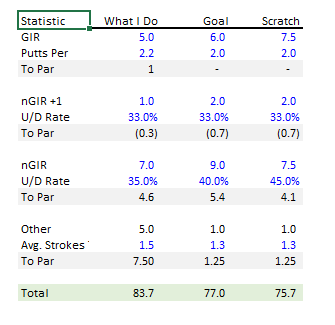Here is a fun thought experiment / mental model for thinking about your game. I call it Papageorgio’s Unified Theory of Scoring. This is loosely based on LSW as well as an interview I heard Will Robins give about the Scoring Method (I have not read, but I think I get the gist of it). Basically, I am regurgitating a bunch of stuff I have read in my own rambling, PapaG style and really none of this is original. I am just very underemployed.
The assumptions:
You have 4 categories of results after hitting your approach in regulation. That is it. This encompasses every golf hole you play. They are as follows:
-
The highly touted GIR…you think you hit a lot of these but you don’t… you think when you hit a 7 iron 5 yards off the green that you have not made a good shot… but you have
-
The lesser tracked, but maybe more important for anyone north of 5 handicap, the nGIR (see example above about the 7 iron)
-
A special subsegment of GIR, that we will call nGIR+1…for the most part this will be 1-2 easy par 5’s on your course that you can reasonably get within 25 yards of the green after 2 shots
- Note: You will need to think about your average GIR’s and subtract out GIR’s that come from nGIR+1 in this model
- This is where almost all your birdies come from… once in a blue moon you hit it tight on a non par 5 or sink a long putt… these are great but they generally do not contribute much to lowering your index
-
The last category could be called “X”, “botched”, “you suck at golf” holes…. if we are being kind to ourselves we could say that we “failed to get inside the scoring zone within regulation”

- These holes are extremely important to analyze… did you hit driver into a penalty area? Did you shank a layup on a par 5? Did you get overly aggressive on a par 5 and hit into a penalty area?
- This is double bogey land…we don’t want to live here…it is not a good place
Given these categories above, I believe there is one fundamental way to get better at golf (I am talking about giving yourself a chance at the vaunted “scratch” label)
You must radically increase your nGIR per round… this is the scoring zone… you will make lots of pars and bogeys from the nGIR zone. If you make lots of pars and bogey’s you will suddenly find yourself shooting in the high 70’s.
“But papageorgio, one time I got up and down 15 times and shot a good score”… good for you… I wish you luck in maintaining a short game above the level of a median tour player.
Here is a numerical representation of the model below. As you can see, I am trying to do a few simple things in my game. I list them below in order of importance:
-
Turn 2-3 of my “out of the scoring zone” results into nGIR per round. You could also call this category double bogey reduction…this is the number one thing that gets you a single digit handicap. I suck at it and I still have a 6-8 index. Seriously go look at my stats. I hit in trouble off the tee about 5 times per round. No bueno but luckily a pretty low bar to improve on!! Do I need to hit the middle of the fairway with a striped 275 drive!!! NO!!! Just don’t hit it in the junk and get within 20 yards of the green on the next shot!.. I find this perspective very empowering. Don’t put unnecessary pressure on yourself… Don’t “Should” all over yourself as the gurus say
-
Turn two of my nGIR into GIR per round… the unfortunate thing is that I actually have to get better at hitting the golf ball to do this as I play with fairly solid strategy today (back of green yardage, center of green or fat side depending on trouble)… it is a bitter pill to swallow but you have to work on ball striking to become good… been chasing this dragon for about 3 years now…one bonus though is that if I quit hitting it into the junk 5 times per round I will have more looks at the green….ARE WE STARTING TO SEE CORRELATION BETWEEN THE FULL SWING MOTION AND SCORING!!!
-
Trying to get marginally better at putting and chipping… almost all of this will come from
-Not making big mistakes from off the green (double chips)
-Improve putting inside 10 ft

This isn’t rocket science. If you get near the green A LOT and have a B or B- short game, you can score just fine.
Most of this is tongue and cheek as I know many of you know this and are on the same page. The main thing I am trying to convey is that nGIR is where it is at. Keep it in play and get near the green. Don’t freak out when you chip and two putt for bogey. You are doing just fine : )
Volume II will be notes on how to manage marital and work expectations while chasing an arbitrary goal in a game that is expensive to play and takes up large chunks of what could otherwise be productive days.


 . I’m in that boat buddy
. I’m in that boat buddy